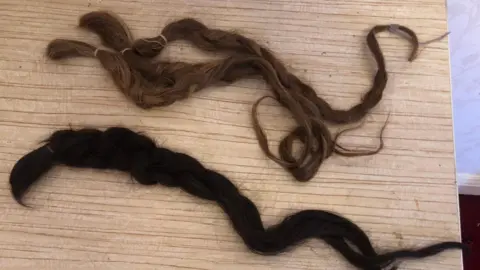Family hair-loom: Ancestors' lost locks rediscovered
 John Devine
John DevineNot everybody gets a chance to physically touch their ancestors, but Richard Baxter has - in an unexpected way.
Mr Baxter, 47, from March, in Cambridgeshire, was clearing out his late mother's home in the town when he peered into a bedroom wardrobe and came across two brown paper bags.
He said he made a discovery he could not quite believe: hair from his great and great-great grandmothers - and it was in perfect condition.
Mr Baxter said he now planned to keep the locks - some dating back to 1897 - for "posterity".
 John Devine/BBC
John Devine/BBC"My mother told me years ago that the hair had been thrown out," said Mr Baxter.
"I had seen the locks as a youngster, and can remember my grandmother telling me that the sandy ones were from my great-great-grandmother."
Ann Walton (nee Bailey) was born in Somersham in 1847 and lived in Whittlesey. She married a builder called Benjamin Walton.
Mr Baxter said he believed Mr Walton built many properties that are still in Whittlesey today.
It is thought her hair was collected and kept as a momento of her when she died in 1897.
 Family contribution
Family contributionIn the second paper bag, Mr Baxter found a much darker, thicker "pony tail" - remarkably like one he used to sport a few years ago.
"Again, the information had been passed down that this was a lock from my great-grandmother, Emma Marie Walton."
She was born in 1877 and died in 1910, and also lived in Whittlesey.
Mr Baxter said: "We were told that around 1908, she got a job working as a nanny in Montague Street, in Bloomsbury."
He was told the photograph of his great-grandmother was taken around the time she got the job in London, because the position required her to have shorter hair. The pony tail was cut off then.
 Family contribution
Family contributionMr Baxter said he will keep the locks "for posterity" and, although other family members and friends think it is "a bit bizarre", he said they were part of his life and he was "very pleased to have them" - especially after thinking they had been thrown away many years ago.
'Escape the decay'
Robert Bell, curator at the Wisbech and Fenland Museum, said the keeping of locks of hair as mementos of both the living and the dead has been common for centuries.
"The choice of hair as a physical reminder of a person probably arises from hair's chemical make up, which helps it escape the decay of the rest of the body.
"The trend for producing mementos using the hair of the dead peaked with the Victorians, who would place locks of hair from their deceased loved ones in jewellery, such as lockets and brooches.
"Whilst familiar with jewellery and small envelopes containing locks of hair, I have never before seen such long tresses as those of Mr. Baxter's ancestors," added Mr Bell.
Follow Cambridgeshire news on BBC Sounds, Facebook, Instagram and X.